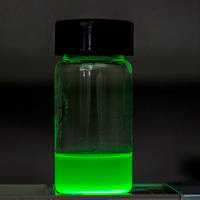(November 18, 2015) A
team of Florida State University materials researchers has developed a new type
of light-emitting diode, or LED, using an organic-inorganic hybrid that could
lead to cheaper, brighter and mass produced lights and displays in the future.
Assistant Professor of Physics Hanwei Gao and Associate
Professor of Chemical Engineering Biwu Ma are using a class of materials called
organometal halide perovskites to build a highly functioning LED. They lay out
their findings in the journal Advanced Materials.
“Early work suggested perovskites could be a promising
material to build LEDs,” Gao said. “But, the performance was not up to their
potential. We believed there was significant room for improvement.”
Perovskites are any materials with the same type of crystal
structure as calcium titanium oxide. Other researchers experimented with
perovskites to build LEDs in the past but could not build particularly
effective ones. Gao and Ma believed this organic-inorganic hybrid could perform
better, if the formula could be appropriately tweaked.
“When we thought about this class of material, we knew it
should perform better than this,” Ma said. “We came up with our novel approach
to solve some critical problems and get a high-performance LED.”

